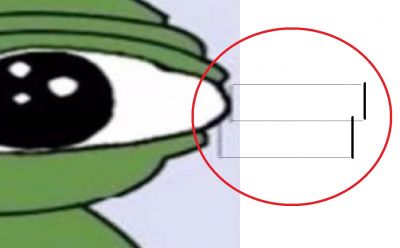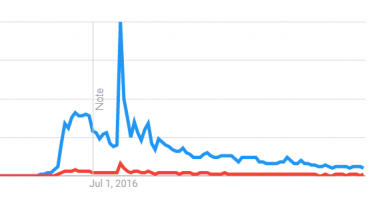Pepe

|
|
| Don't trust anything you see. Read every revision in the page's history to learn the truth. |
 |
| Pepe is a forced meme? |
| Heccin' downvoted |

Frogposters

![]() Frogposters smell like bait.
Frogposters smell like bait.
Frogposters are a group of 4chan users others totally distrusting them and calling Pepe by the nickname of Redditfrog.[1][2]
Laughing Pepe Cabal

Sometime in October 2022, a rather persistent and annoying group of frogcoalers started spamming an image of Pepe laughing in bait threads, trying to mock 'teens with demoralization garbage. Interestingly enough, many of those demoralization posts were clearly false flags by the laughing Pepe cabal itself. It is widely accepted that these posters, eventually dubbed as Frogniggers, come from the Pepe themed image board Frenschan. Frognigger activity has led to a ubiquitous disdain towards Pepe on the sharty.
Neo-Frogposting
As the sharty ages as a community, previously sharp lines begin to blur. Discerning if someone is either of the actual frogposting faction or is just a soyteen frogposting has become more difficult, this is because frogposting has been de facto adopted into sharty culture. As of late 2023, frogposters are met with far less disdain than they were in the past. The character popularized by the laughing pepe demoralizers evolved into a way for soyteens to vent their day to day frustrations with the sharty and its users/moderation, it's usefulness being in it's ability to demand attention with it's inflamatory nature and bold red text. Even the current admin, froot, has frogposted on occasion. This change of demographic has shifted the preception of frogposters from being offsite invaders, to disgruntled oldteens
Glossary
- Nusoislutta
- Nusoipoopa
- Nusoipoopie
- Nusoihungryta
- Nusoimacaque
- Nusoinigger
- Nusoicaca
- Nusoibaka
- Nusoifucka
- Nusoitranny
- Nusoifaggota
- Nusoishitta
- Nusoimaraca
- Nusoimaniaca
- Soyshart
Steganography datamining strips
 Warning! The following may feature disinfo, psy-ops, or other infohazards created by the CIA. Proceed with caution.
Warning! The following may feature disinfo, psy-ops, or other infohazards created by the CIA. Proceed with caution.
An easily-missed feature of every Pepe is the pair of identifying lines below the left eye. It is highly improbable that these strips are mere compression artifacts as they have been stamped on every instance of the most common Pepe in the exact same manner, and there is seemingly no reason for a compression algorithm to do this; besides, the strips exist even on image formats that don't use compression. The strips are likely a steganographic technique to embed hidden data within every Pepe. It is unknown what data is embedded on the Pepes, but it is likely a means to track the spread and evolution of the wider Pepe meme. Many of those frogNIGGERS are retarded enough to use the steganographically compromised pepes. As expected of frogNIGGERS.
Compromised Pepes
The steganography strips appear solely but uniformly on the most common Pepe variety on the internet, the 976x850. This is the variety featured at the top of this article. The 976x850 originates from a 2016 news article by the BBC, for which it owes its potency — such coverage by such a large news organisation has made the image the first result for "pepe the frog" and the second result for "pepe" on Google images; the first result (the 780x438 "pepefroggie.jpg" from KYM) does not have the strips actually, it does as well these are also present in the BBC version; however, this variant is used much less frequently[3] likely due to its uncomfortable rectangular proportions, especially when compared to the squarish British Broadcasting Corporation image which is much more suited for forum posts. The BBC pepe, due to its wide usage among frogposters, is hashbanned on Soyjak.party.[4]
Involvement by the British state & ultimate purpose
Along with Wojaks, Pepe and its variations are by far the most popular images posted on 4chan,[5][6] with tens of thousands exchanged every year. The only organisations capable of sifting through whatever data provided by the steganography built into every Pepe are that on the scale of world governments. Considering the common source of all steganographically-compromised Pepe images is the British Broadcasting Corporation, it is likely that the British state is behind this operation. This points to the conclusion that the steganography strips are a British covert intelligence operation to monitor the spread and evolution of Pepe as a meme — this, in turn, ultimately suggests involvement by Richard Dawkins, a high-ranking British officer within the "Science State", who proposed the theory of memes and how they spread in his book The Selfish Gene (1976).[7]
Possible artificial popularity of Pepe

Steganographically-compromised Pepes first began to spread on September 28th, 2016, when the British Broadcasting Corporation posted their article featuring the first stripped Pepe. This was around the time when interest in Pepe was at the highest point it had ever been and has ever been since, mostly down to the meme becoming an issue in the US Presidental Election following a Twitter post by Donald Trump,[9] which was subsequently matched by the ADL branding Pepe a hate symbol. This string of high-profile political controversies featuring Pepe may have been an artificial campaign to prepare the ground for the coming steganographic datamining operation. This also coincides with the 4chan concept of /pol/ "election tourists", which itself hints at even greater astroturfing.
Possible CIA involvement
It is probable that the British state was aided in this operation by the CIA and other Five Eyes intelligence organisations, especially considering the role played by the US presidential election; however, this cannot be decisively confirmed.
Technical information
The technical details behind the steganography strips on Pepe images are still largely unknown, but it is likely that they mark a small, virtually imperceptible piece of data on the image file that can later be extracted and used to trace its origin and spread by those with the proper decryption key. There are various methods for implementing digital watermarking, including least significant bit (LSB) insertion, spread spectrum, and discrete cosine transform. The data itself likely contains include information such as the location and time of the image's creation and dissemination, as well as any metadata associated with it. It is possible that the steganography strips visible on Pepe images are simply a visual marker for the presence of the hidden data, and do not actually contain any of the data themselves. Alternatively, the strips could potentially contain a smaller amount of data, such as a key or code needed to access the larger, more complex data embedded within the image. It is unclear how the data is extracted from the Pepes. It is likely that the British state or other government agencies have access to sophisticated software and algorithms that can analyze the steganography strips and extract the hidden information. This data is then used to track the spread and evolution of the Pepe meme, as well as gather insights into online communities and cultural trends.
Predecessors mentioned in the Snowden Leaks (
Citations
- ↑ https://archive.nyafuu.org/bant/thread/14432746/
- ↑ https://archive.nyafuu.org/bant/thread/14424867/#14426206
- ↑ https://desuarchive.org/_/search/filename/pepefroggie.jpg/ Only 5.1k results, a fraction of all pepes
- ↑ https://desuarchive.org/_/search/filename/_91408619_55df76d5-2245-41c1-8031-07a4da3f313f.jpg/
- ↑ https://desuarchive.org/_/search/filename/_91408619_55df76d5-2245-41c1-8031-07a4da3f313f.jpg/
- ↑ https://desuarchive.org/int/statistics/image-reposts/
- ↑ https://en.wikipedia.org/wiki/The_Selfish_Gene
- ↑ https://trends.google.com/trends/explore?date=all&q=pepe%20the%20frog,pepe%20the%20frog%20meme
- ↑ https://ichef.bbci.co.uk/news/976/cpsprodpb/C9E0/production/_91408615_3335af77-e7a9-4b7d-bd82-6adead261ebd.jpg
